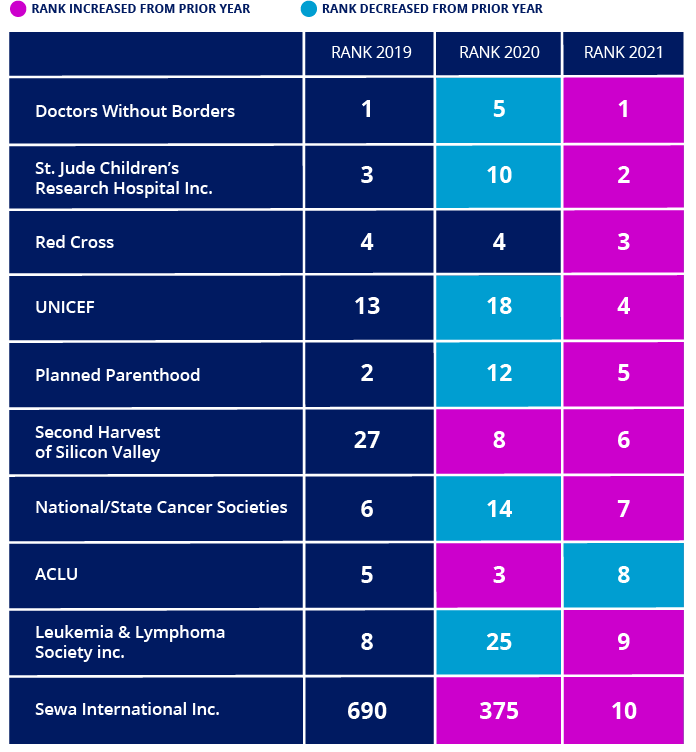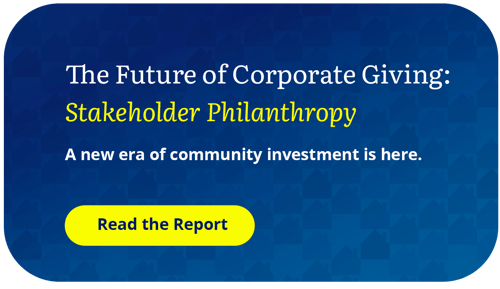The State of Corporate Purpose 2022
Purpose Is Changing the Way We Do Business
Published June 2, 2022

Purpose Is Changing the Way We Do Business
The dramatic events of the past few years have changed us. Since our world was first turned upside down in 2020, we’ve seen a huge tilt toward corporations and their stakeholders taking action beyond their backyards, rallying around critical issues that matter for the global good.
If the past year has taught us anything, it’s that more than ever there’s a collective need for connection to something bigger than ourselves. Amidst the Great Resignation, and the search for higher-quality jobs with more flexibility, autonomy and better pay, employees are also seeking purpose, meaning and impact in every part of their lives — including at work. Customers want their brands to care as much as they do. And companies are responding to the demand to act on social, environmental and cultural imperatives. They’re becoming central figures in creating community, catalyzing positive action and meeting the moment in times that matter.
In 2021, Benevity’s community did more good than they did before and during the pandemic. What started as a crisis response in 2020 has become a sustained movement, in many cases supporting not just the urgent and immediate need, but getting at the underlying issues that contributed to the crisis in the first place.
In 2022, corporate purpose is no longer a nice-to-have — it’s business critical.
Benevity’s data and insights from our community of more than 850 companies with 20 million employees and hundreds of millions of customers reveal five top trends shaping the future of corporate purpose in 2022:
-
1
In times of need, businesses are stepping up
-
2
At the root of the Great Resignation is the Great Search for Purpose
-
3
Employee-led action on diversity, equity, inclusion and belonging is changing corporate culture from the bottom up and the inside out
-
4
The future of corporate philanthropy is stakeholder philanthropy
-
5
ESG is how shareholders understand purpose
The takeaway?
Purpose, connection, action and impact coupled with stakeholder engagement are the ways we will do business — today and in the years to come.
The Story of 2021:
A Movement Toward Sustained Impact

As we looked for ways to make a difference coming out of the painful events of 2020, record-high levels of donations were maintained. Each of us dipped into our wallets to donate just a little bit more than we did before the pandemic struck. We also donated more often, reflecting a desire to positively change society in a more sustained way.
purpose-driven companies
positive actions taken
volunteer hours tracked
in donations
grants worth $2.95b
causes supported
We kept on giving
2020 was an unusual year, so it’s not surprising that we saw double-digit growth with a 13% year-over-year increase in average annual donation dollars per donor compared with 2019. In 2021, donation amounts settled back a bit, but we still saw a bump in the baseline compared to pre-pandemic levels with donations per donor, including corporate matches, growing 2% from 2019. This represents a small but notable increase in donation amounts outside of an anomalous year.
We saw significant fluctuations in donation frequency in the past three years. Unsurprisingly, with disruptions caused by COVID-19 and remote work, frequency in 2020 dropped from 13.7 to 9.7. However, 2021 saw a 9% increase in donation frequency over 2020, representing a slow but positive step toward recovery.
We volunteered more
Volunteering saw significant growth in 2021 as many organizations bounced back from closures and disruptions caused by COVID-19 and volunteers gladly resumed their community commitments.
At least part of the growth can be attributed to more companies responding to the desire of today’s workforce to experience more purpose at work by launching employee volunteering programs with virtual components, empowering employees to participate from anywhere, any time, and tracking and rewarding participation in their programs.
total volunteer hours tracked
↑ 28% growth from 2020
total number of
individual volunteers
↑ 28% growth from 2020
total causes with volunteer
time tracked
↑ 23.5% growth from 2020
total % of companies
with volunteering programs
In Times of Need, Businesses Are Stepping Up

From defining moments to grassroots investments
In 2021, companies shifted the way they made social investments. In their quest for purpose and a heightened focus on making a meaningful impact on some of society’s most pressing social issues, they showed stakeholders that they could be trusted to do the right thing.
In 2020, in the face of urgent moments such as the height of the Black Lives Matter movement, there was a great deal of corporate granting to causes addressing timely needs related to social and racial inequities. But in 2021, in the wake of that urgent response, we saw more grants given to local community organizations that are working at the grassroots level to address the underlying issues at the root of those inequities and injustices.
Grants to community improvement and capacity building
Grants made to the cause category of Community Improvement and Capacity Building climbed four spots from 2019 to 2021.
Grants to civil rights, social action and advocacy
As a cause category, Civil Rights, Social Action and Advocacy remained in the top 20 but dropped back from 11th in 2020 to 16th in 2021.
Top cause categories* receiving corporate grants from 2019 to 2021
* National Center for Charitable Statistics: National Taxonomy of Exempt Entities (NTEE) Codes
Companies and their people
still stepped up in a crisis
Even as community-based causes received increased corporate support in 2021, we continued to see people mobilize quickly in response to emergencies, giving them an important role to play in ameliorating the lives of others during some of the most difficult times of the year.
Top 10 causes supported via donations by companies and their people

COVID-19 crisis in India
Afghan sociopolitical crisis
Anti-Asian racism
Vaccine equity
unique vaccine equity causes supported
total donated to vaccine equity causes
volunteer hours tracked for vaccine equity causes
Client Story
Dolby supports those closest to the Ukraine crisis


Dolby supports those closest to the Ukraine crisis
When Ukraine was invaded in February 2022, Dolby Laboratories quickly sprang into action to support their team in Poland and seek their guidance on how best to respond. They activated with a global donation matching campaign supporting the humanitarian crisis and provided corporate grants to several organizations nominated by Poland’s Dolby Cares leaders. Polish employees activated quickly and continue to step up in many ways including hosting refugee families, triaging at train stations and refurbishing laptops for families hosting children. The company provided extra days off and a stipend to help them purchase extra supplies and necessities. Since Dolby allows volunteer hour tracking for acts of kindness, employees received volunteer rewards for their time, allowing them to further amplify their impact.

How companies can address enduring issues
With more awareness of the impact that can come from a corporate culture that empowers social action, companies are wisely moving toward broader, more consistent support for the causes that matter most to their employees, their customers and their communities. Here are a few ways to create a genuine culture that engages your stakeholders in purpose while delivering meaningful impact:
-
Commit to long-term grants based on trust and partnership. Grant programs, regardless of size, are becoming increasingly collaborative and are resulting in more unrestricted support for grantees with less administrative burden and more conversation between companies and nonprofits. In this way, they’re providing more opportunity to maximize impact based on the insights, needs and expertise of each partner — especially nonprofits working on the front lines to serve their communities.
-
Make more investments in smaller, community-based grants. Small investments in community-oriented causes can have outsized social impact for grassroots nonprofits and their beneficiaries while at the same time boosting your profile as a purpose-driven brand in the communities you operate in. Garner input from your employees (including affinity and employee resource groups), customers and communities on which organizations you can support.
-
Run donation matching campaigns. Incentivize employees, customers and the public by matching donations to causes of their choosing regularly, or run campaigns with higher matching rates during specific time periods or in response to events.
-
Reward volunteers for their skills, time and kindness. Offer volunteer rewards for various types of volunteering, whether it’s in support of a nonprofit or simply an act of kindness. This shows your people that you value all the ways they give of themselves to make the world a better place.
-
Support Goodness year-round. Give people the tools to learn and take action any time of year, while also amplifying your support during key awareness dates that matter to them, whether it’s International Women’s Day, Pride, Indigenous Peoples’ Day or something else.
-
Give people a voice. Empower people to support the causes that matter to them alongside the causes that matter to you as a company; this demonstrates that the causes your stakeholders care about are just as important to you as what you care about as a company.
-
Source and publish educational content. Tap partners or employees to create content that you can share with your company to help people grasp the depth of the issues. Pair informative materials with suggested actions they can take at work or at home. This will leave your people with both the information and the inspiration to do something to make a difference.
At the Root of the Great Resignation Is the Great Search for Purpose

A brave new purpose-driven world:
employees urge companies to take action
Whether it’s boomers retiring early, low-wage workers seeking better workplace conditions, the disproportionate burden placed on women to be the primary family caregiver, or people looking for more purpose and autonomy in their lives, there are a number of factors contributing to what is now known as the Great Resignation. While many people associate this trend with the emergence of COVID-19, the truth is it has been growing steadily for a decade.
And the data shows that today’s workers, particularly Millennials and Gen Z, prefer brands that allow them to have a positive impact — whether it’s the brands they support with their buying habits, or the places they choose to work. In other words, they have new criteria for who they do business with, and their prioritization of values hit a tipping point in late 2021. With employee retention and engagement becoming more urgent concerns than ever before, companies are adapting their thinking to prioritize what’s important to their people.
A 100-person company who provides an average salary of $50,000 could have turnover and replacement costs of approximately $660,000 to $2.6 million per year, depending on their retention rate.
Companies are redefining how they
engage their people in social action
The message that companies need to take action and help their employees do the same is loud and clear. But the pandemic complicated the issue by forcing companies to adopt hybrid working models with less face-to-face interaction between employees, teams and leadership and the communities they serve. This made empathy, connection, engagement and retention even more difficult. Companies who were able to quickly adapt their purpose programs, in the form of virtual volunteering and recognizing other positive actions, saw the benefits.
When in-person volunteering dipped as a result of COVID-19 closures, virtual volunteering emerged — and remained relevant.
Growth in virtual volunteering
Note: Volunteer hours include hours tracked for volunteer opportunities only
Companies are also including volunteer acts of kindness in their programs — a way for people to give time and support without it being tied to a specific nonprofit, but instead for the benefit of individuals or communities directly. Examples include picking up litter on a beach or in a park, buying groceries for an elderly neighbor, or participating in learning opportunities at company-hosted events like panel talks on issues around inclusion and impact.
%
of volunteer hours tracked in 2021 were volunteer acts of kindness
%
of companies who offer volunteering allowed volunteer acts of kindness in 2021 —
up from 78% in 2020
Positive actions, alongside learning opportunities, are being used by companies to empower their people to do good.
%
growth in companies promoting learning and positive action
%
growth in the number of opportunities for positive action available in company programs in 2021
Companies have also found new ways to connect with a distributed workforce.
%
growth in companies using the Benevity mobile app to share opportunities with their employees
Client Story
Starbucks empowers community champions


Starbucks empowers community champions
Starbucks’ vision is to empower each of their employees — who Starbucks calls “partners” — to be a Community Champion. The company offers many ways to make a positive impact, including donating unused food nightly as part of their stores' FoodShare food donation program, planning and participating in community service events, hosting donation drives in-store and nominating nonprofits for grants. In the company’s fiscal year 2021, more than 18,000 partners globally engaged as Community Champions, participating in over 2,900 community events and giving more than 45,000 volunteer hours to local nonprofit organizations. In the U.S. and Canada, Starbucks matches up to $1,000 annually for both full-time and part-time partners’ eligible contributions to nonprofits, which resulted in Starbucks donating over $1 million to over 2,000 nonprofits.

More companies celebrate GivingTuesday
Most giving takes place between September and December each year, with particular focus in recent years on GivingTuesday, a global awareness day meant to counteract the consumerism of Cyber Monday. In 2021, Benevity saw massive growth in the number of companies getting involved in this global movement — engaging their employees, nonprofit partners, customers and the public in their campaigns. This led to almost double the amount of donations made on this single day compared to in 2020!
GivingTuesday packed a punch for companies and their people in 2021
%
of companies participated
in GivingTuesday
$ .6m
in donations, matching and grants
↑ 103% from 2020
Volunteer hours logged
↑ 46% from 2020
total Acts of Goodness*
↑ 17% from 2020
causes
supported
*An Act of Goodness is a metric designed to capture a wide breadth of actions in corporate programs, including and beyond traditional giving and volunteering, and it accounts for the ways that Benevity clients and their people encourage, approach, and engage in Goodness.
Doing good feels good: how purpose improves mental health and social connection
The last few years have brought conversations about mental health to the forefront in the workplace, as people were faced with social isolation, juggling work and caregiving responsibilities, and a barrage of other crises that affected our sense of well-being. As a result, companies found new ways to invest in the mental health of their employees and are seeing the direct benefit of creating a supportive culture that truly values the power of Goodness.
Studies have shown that when people do good, the pleasure center of the brain lights up and releases oxytocin — the powerful hormone that is known for creating bonds between people, teams, companies, families, and even babies and pets! This phenomenon also explains why volunteers and givers tend to report better health as well as reduced anxiety, stress and depression.
A commitment to the mental health of employees can save companies money and help them retain a healthier, more engaged workforce. And promoting a culture of Goodness can make the world better — one person and one small act at a time.
%
increase in oxytocin from
donating money to strangers or
taking positive actions, resulting
in better health and more
social connection
How to build culture in a hybrid world
The swift shift to hybrid working put a lot of pressure on companies to pivot their operations and adapt their cultural norms to the new digital reality. What we learned as time went on is that the companies who kept their employees engaged by building meaningful connections, providing them with a sense of purpose and creating a culture where they could feel a part of something bigger than themselves (and their day-to-day work) were better able to engage and retain their talent, despite the lack of in-person experiences.
Here’s what we learned about the steps companies can take to engage people in purpose in a hybrid world:
-
Build connectivity through communications.
Leverage all of your platforms to reach out to your people — no matter where they are — to ensure they feel connected to the culture and to each other, whether that’s through employee communications, intranets, social networks, apps, or team meetings and leaders. The biggest reason people don’t engage is because they don’t know there are opportunities to do so! -
Engage employees in purpose virtually.
Build an inclusive purpose program by providing your people with the opportunity to participate in virtual options or ways that they can participate in their own neighborhoods on their own time, like in runs, walks, cleanups or acts of kindness. -
Focus on employee experience, learning and skills-building.
Embed volunteer opportunities in employee onboarding and host learning sessions that count toward volunteer time throughout the year. -
Empower your people to support their own passions.
Create grassroots movements by allowing employees to share their own giving or volunteering opportunities, and let them add their own matching dollars to fundraising initiatives, too. -
Rethink the definition of volunteering.
Remove barriers by expanding the definition of volunteering to include learning, acts of kindness and virtual opportunities, while enabling your people to champion the causes they care about by letting them lead initiatives and events.
Employee-Led Action on Diversity, Equity, Inclusion and Belonging Is Changing Corporate Culture From the Bottom Up and the Inside Out

The rise of affinity groups
In 2021, affinity and employee resource groups (ERGs) driven by passionate employees proved to be one of the most powerful ways to foster a more diverse, inclusive workplace and help employees feel a real sense of belonging and purpose at work. A successful group not only gives people space to be themselves, but it can bring new ways of looking at issues, create connections and drive innovation. It can also act as a critical resource for companies looking for insights into experience gaps, employee dissatisfaction and systemic bias or barriers.
Members can act as trusted advisors for both employees and employers by building communities, creating secure spaces, promoting understanding and championing a culture that strives for positive change — inside the company and out in the world. These high-trust relationships are a foundation upon which corporate culture can grow and flourish.
And in an increasingly competitive talent market, marked by burnout and fears of productivity loss, the sense of belonging that can be fostered by affinity groups and ERGs has a powerful impact on recruiting and retention efforts — especially as remote work can make our social ties a little bit more tenuous and difficult.
The benefits of belonging
Causes focused on diversity
and social justice rise in the ranks
In the year or so following the Black Lives Matter movement becoming more prominent, 2021 showed us that companies and their people continue to support social and racial justice causes at higher levels than ever before. While several of those causes who earned a swell of support in 2020 remained in the top 10 social justice causes in 2021, they were joined in 2021 by Asian-affirming and LGBTQ+ causes as well.
Chinese for Affirmative Action and Asian Americans Advancing Justice saw significant growth in support in 2021, as did The Trevor Project, a leading LGBTQ+ organization.
Top social justice causes in 2021
*Black Lives Matter fiscal sponsor starting July 2020
Social and racial justice causes averaged 3.3% of total giving from January 2019 to April 2020. After a dramatic spike during the Black Lives Matter movement, the average of total giving to these causes settled at 5.2% from September 2020 to December 2021, resulting in a 58% increase in the baseline of giving to these causes.
Although many companies expressed their support for anti-racism movements in the second half of 2020 and into 2021, Benevity data shows there is still often a gap between statements and action.
How companies can act as DEIB catalysts
Companies are at the center of the conversation about diversity, equity, inclusion and belonging (DEIB) and are increasingly engaging their people in learning how to tackle enduring social and racial inequity. While there may be some gaps between statements and actions, we know that every gap represents an opportunity.
Here are a few key principles that will help companies of all sizes succeed in harnessing the power of their employees and their affinity and employee resource groups (ERGs) to deliver impact.
-
Invest in affinity groups and ERGs. Show your employees you care about what matters to them by creating an environment in which they’re empowered to gather, plan events, learn together and take action on issues within and outside of the company.
-
Pair your ERG initiatives with your corporate social responsibility (CSR) programs. Just as you might have volunteer champions or local ambassadors for your CSR programs, extend those networks to include affinity groups and ERGs, who are tapped into employee communities that are seeking belonging and wish to take action. Work together on events or communications and enable your ERGs to promote giving back to the causes that matter to them.
-
Back up your talk with action. Complement every internal and external commitment with an actionable Goodness opportunity or a grant that proves that you are not just talking but taking action. Even better, engage your people in choosing or influencing those opportunities and grants to increase the sense of co-creation and ownership of strategy and outcomes.
-
Consult ERGs on your granting. Affinity groups and ERGs tend to bring together passionate subject matter experts on specific causes and issues. Consult with these leaders to better understand the issues facing their communities and seek their input on prospective grantees.
-
Elevate ERG leaders as spokespeople. Provide your engaged group of leaders with the opportunity to become spokespeople and empower them to promote DEIB themes in their communities. This will boost your employer brand internally and externally and show your people you truly value their voice.
-
Celebrate your successes. Take the time to acknowledge employee activities, actions and expertise, and celebrate their work with donations to organizations of their choice to help make their impact go further.
The Future of Corporate Philanthropy Is Stakeholder Philanthropy

Evolving toward stakeholder philanthropy
The future of philanthropy is going to be democratized and will require the engagement of more stakeholders than ever before, including nonprofits, employees, customers, affinity groups, ERGs, community boards and even those who benefit from the efforts of all the above. Participatory grantmaking is the way of the future. It brings in the voice of more stakeholders to determine funding areas and approaches, identify partner organizations and make lasting change.
Transparency and engagement in corporate giving decisions drives positive consumer and employee actions
%
of consumers are likely to shop at or support an organization that seeks their input into where the organization gives
%
of employees are likely to work for an organization that provides transparency into how they allocate their charitable donations
%
%
of employees believe that stakeholders should have a say in how a business allocates its charitable funds
%
of consumers say the more a business engages its consumers in charitable giving decisions, the more trust they have in that business
%
of employees say the more a business engages its employees in charitable giving decisions, the more trust they have in that business
Note: All stats from Benevity report The Future of Corporate Giving: Stakeholder Philanthropy.
How to build trust and engage stakeholders
-
Engage your internal audiences. Talk to your ERGs, CSR leaders and team members with lived experiences, and invite them to be part of your funding decisions and processes.
-
Engage with external audiences. Consult with members of your community, including boards, coalitions and nonprofits, to help set your giving priorities.
-
Use your DEIB lens. Apply the same strategy and practices to your relationships with nonprofits that you do with your employees, ERGs and CSR teams. Make sure you have an equitable approach to how you make decisions and issue grants — remove bias wherever you can and increase the accessibility of your applications and forms.
-
Offer skills-based volunteering alongside grants. Give your people the opportunity to engage with the causes you’re funding, building even deeper ties between your company and the grant recipients.
-
Run matching campaigns for your grantees. Increase awareness and engagement with your grantees by offering special matching rates to employees or customers for these organizations, or by running campaigns that incentivize awareness and engagement with these important causes.
Client Story
Zuora’s unrestricted grants


Zuora takes unrestricted granting to heart. In fact, their application form states, “We want organizations to use our unrestricted funding to support their most critical needs, which include operating expenses and overhead.” Instead of quizzing nonprofits about their results, their application process involves learning more about the organization and its goals. They actively seek feedback on the application process — how long it takes and how draining it is on the organization’s resources. These are just a few ways they show that they trust their partners.
Seeding social enterprises
Just as corporate funders are helping to address social problems through charitable activities like grants and giving, they’re also using business itself as a solution. While this used to be a progressive strategy employed by a small portion of companies, more corporations are providing seed capital for social enterprises: companies whose goal is to achieve social, cultural, community economic or environmental outcomes, while also pursuing profits. This trend is helping to create a larger ecosystem of impact-oriented businesses and further breaking down silos between the concepts of for-profit and nonprofit with for-purpose being the new way in which many organizations operate.
How to build entrepreneurial relationships
-
Fund beyond philanthropy. Look for opportunities — or create a fund — to provide seed capital for social enterprises that will improve your communities and the causes you and your people care about and are led by communities who can benefit from economic empowerment.
-
Plan for long-term impact and value. Make investments with an eye on the future and a deep commitment to genuine change — not just quick wins or positive public relations stories. The change you make will outlast any PR campaign.
-
Amplify the social enterprises you support. Use your audience reach and marketing resources to help your social enterprises tell their purpose-driven stories so they’re more likely to garner awareness and traction.
ESG Is How Shareholders Understand Purpose

The desire to see purpose in action is not new for employees and consumers, but it’s surely attracted the attention of investors. Environmental, social and governance (ESG) policies and strategies have taken on increasing importance for shareholders and boards. Just look at the marked rise in ESG searches in the last five years.
At the same time, recognition is growing that ESG needs to go beyond reporting, compliance and risk mitigation strategies if it is to live up to its ideals. It has to be engagement-driven and enroll employees, customers and other stakeholders in authentic, meaningful ways that boost impact and trust.
ESG has now proven to be a major value driver on its own — it will only remain so if we stay steadfastly committed to the power of doing well by doing good.
ESG searches 2017-2022
ESG drives bottom-line results for companies
ESG leaders can realize the following benefits:
Data provided by McKinsey & Company. Typical ranges based on assessments of ESG and financial performance and expert interviews. Estimates may vary based on company and sector.
The Year of the “S”
Most companies have had the opportunity to mature on the “E” and “G” of ESG, with the “S” lagging behind in many cases. The pandemic, the Black Lives Matter and #MeToo movements, and myriad other trends and crises over the last few years have caused companies to prioritize social impact alongside environmental and governance practices. A strong corporate purpose program has become a foundational tool in this evolved thinking about the “S.”
How to operationalize ESG
-
Keep the E and S linked. For your ESG strategy to be effective, keep in mind that the scope of E and S is broad and there is overlap. Important issues like climate change and Indigenous rights are examples of ESG priorities that intersect and shouldn’t be siloed.
-
Listen to your stakeholders. Effective ESG strategies are shaped by everyone that contributes to your culture — not just your board members. Solicit employee input on topics like DEIB and tie your ESG strategies back to your company’s purpose program.
-
Focus on transparency, accountability and action. Not only must companies be transparent with and accountable for their social and environmental commitments, they need to back them up with authentic, empowered action so their stakeholders can participate and trust that the company means it.
-
Show your impact. As expectations grow, so does the desire to see the tangible results of your ESG initiatives. There are numerous reporting frameworks with no one way to tell your story effectively; but, reporting back to your stakeholders (including your employees!) and storytelling will inspire belief in what you’re doing and encourage more companies like yours to join you on the journey in building the movement of purpose-driven business.
Purpose-Driven Business Is Our Path to a Better Tomorrow

As the world changed right in front of our eyes over the last couple of years, we witnessed companies and their people rally together to create the Goodness we so sorely needed. And we see even more proof today of something we’ve long suspected — that corporate purpose is done best when it’s democratized. When voices from every community and every walk of life are included and considered.
Because companies who act with purpose can do things that few other institutions can. They inspire and amplify grassroots movements. They act as catalysts of change and create a sense of connection. They give us hope. They foster a sense of belonging among their employees that helps people feel better about their work. They drive tangible business outcomes for investors, customers and employees alike. And they change the world one person and one company at a time.
As we emerge from a global pandemic into a world of purpose, 2021 showed us that the best is yet to come.



